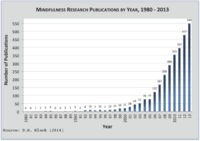Integrating Mindfulness in Project and Program Management
(→Recent research) |
(→Individual Mindfulness) |
||
| Line 38: | Line 38: | ||
|- | |- | ||
| A state of consciousness in which attention is focused on present-moment phenomena occurring both externally and internally | | A state of consciousness in which attention is focused on present-moment phenomena occurring both externally and internally | ||
| − | | Dane (2011, p.1000) | + | | Dane (2011, p.1000)<ref name=Dane2011> |
|- | |- | ||
| A meta-cognitive ability defined as "a state of being attentive to and aware of what is taking place in the present" and involves conscious perception and processing of external stimuli (in contrast to automatic tendencies) | | A meta-cognitive ability defined as "a state of being attentive to and aware of what is taking place in the present" and involves conscious perception and processing of external stimuli (in contrast to automatic tendencies) | ||
| Line 72: | Line 72: | ||
These findings suggest that the mindfulness of one person in an organization can influence the well-being and performance of others and also that '''individual mindfulness practice can have an impact accross all levels of organization, ranging from strategic and tactical to operational.''' | These findings suggest that the mindfulness of one person in an organization can influence the well-being and performance of others and also that '''individual mindfulness practice can have an impact accross all levels of organization, ranging from strategic and tactical to operational.''' | ||
| − | |||
===Collective Mindfulness=== | ===Collective Mindfulness=== | ||
Revision as of 20:18, 25 September 2016
Mindfulness is a state of consciousness in which attention is focused on present-moment phenomena occurring both externally and internally (Dane, 2011) [1]. This present-moment phenomena can also include embarking in creative imagination about the future, problem solving in the present or analysis of the past - as well as a discerning capacity of observing the present situation and context without falling into habitual tendencies or routines. This targets a number of challenges for Project and Program managers in where, due to time pressure, uncertainty and personal cognitive biases, sub-optimal decisions are often made highly impacting the projects outcomes.
This article intends to build upon the growing number of theories and evidences of the benefits of mindfulness, from two perspectives: individual and collective. It will draw from the latest research on the topic and link it to the existing framework for Mindfulness in High Reliability Organizations (HRO), developed by professors Karl E. Weick and Kathleen M. Sutcliffe. Finally, the article will finish by suggesting potential tools and areas of integration for Project and Program Managers practice.
Contents |
Context
Historical definition of Mindfulness
The earlier account of the meaning of the world mindfulness comes from the Pali-term sati, simply meaning a state of non forgetfulness, bearing in mind a given object of attention. This includes retrospective memory of things in the past; prospective memory, to remember to do things in the future; and present centered recollection in the sense of maintaining attention to the present reality. [2]
In several contemplative traditions mindfulness this mental factor is viewed as a pre-requisite to: 1) Develop attention/concentration skills 2) Develop empathy and altruism; and 3) Developing cognitive balance. The latter can be generally understood as the self-awareness of our own internal mental processes, cognitive biases and tendencies, and the degree of freedom to which an individual can refrain from acting on them.[3]
Mindfulness in the West
Even though there are earlier accounts of Mindfulness in the West, the recent popularity of the concept of Mindfulness in the West is generally attributed to Jon Kabbat-Zinn and his work on Mindfulness Based Stress Reduction (MBSR) programme. The adoption of mindfulness related practices/training has been widespread, ranging from training and development programs of major corporations from Google to General Mills, to programs in prisons to prevent work burnout of juvenile guards.
Universities, too, have taken up the call. For example, the director of mindfulness education at UCLA’s Mindful Awareness Research Center leads on average 200 people every week in a silent Mindfulness Awareness meditation class held at the Hammer Museum’s Billy Wilder Theater [4]
Recent research
The past 30 years have seen exponential growth in research of Mindfulness. Much research concerned with the development of individual-level mindfulness maintains that mindfulness can be developed through meditation. The research takes its cue from Jon Kabat-Zinn's MBSR programme but also a variety of other Mindfulness Based Interventions (MBIs) i.e.: mindfulness-based cognitive therapy [5]
Building on the view that mindfulness is a byproduct of meditation experimental research has shown that state mindfulness can be activated through brief meditation-related instructions and exercises [6] [7]
The growth in mindfulness research literature from 1980-2013 is shown in the graph at the right-handside.
Individual Mindfulness
| Definitions | Source |
|---|---|
| A state of consciousness in which attention is focused on present-moment phenomena occurring both externally and internally | Dane (2011, p.1000)[1] |
Cite error:
<ref> tags exist, but no <references/> tag was found

